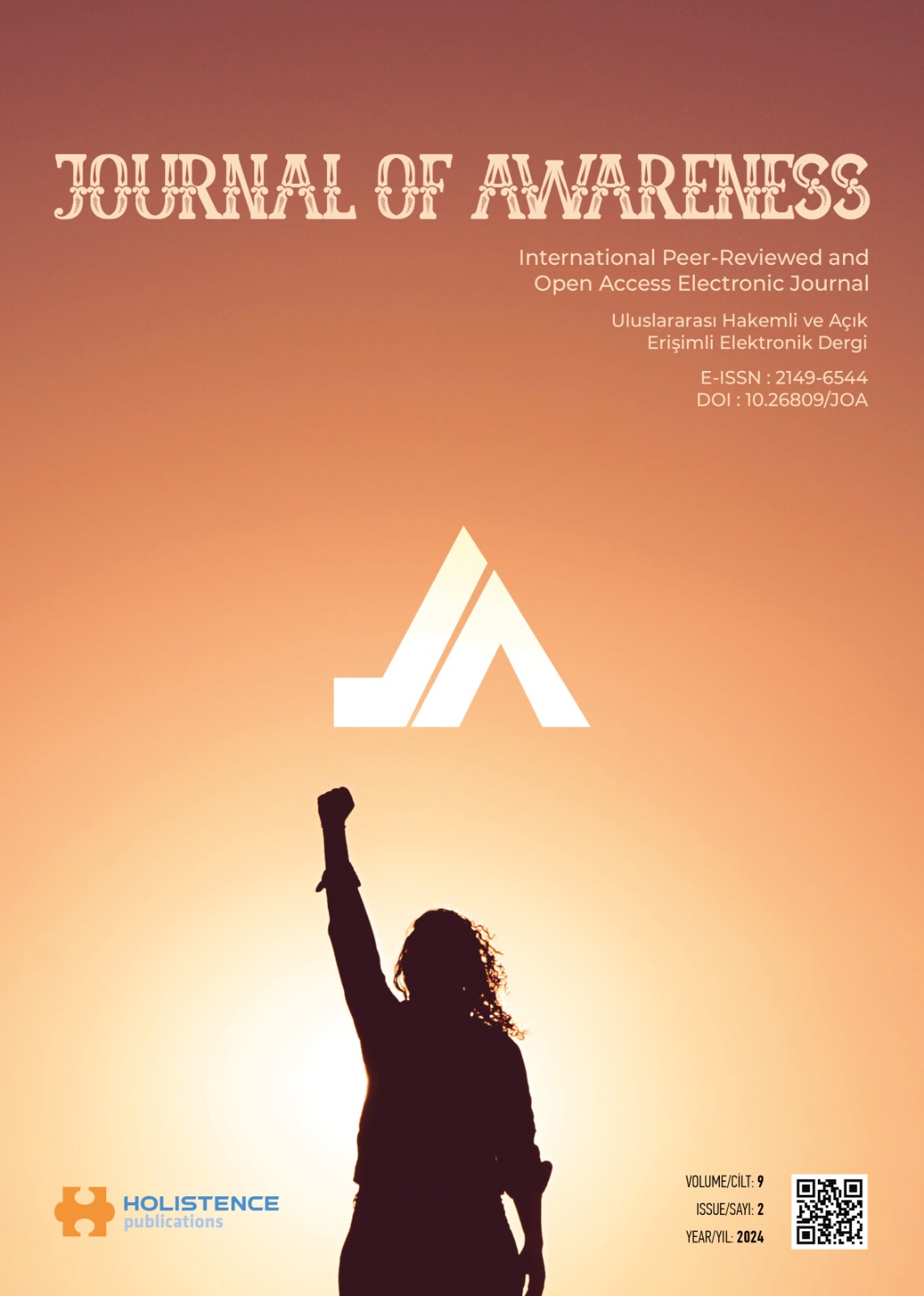Yenilikçi ağ modelleri kapsamında yerli tıbbi cihaz tasarım süreçlerinde endüstriyel tasarımın rolü
DOI:
https://doi.org/10.26809/joa.2292Anahtar Kelimeler:
Endüstriyel Tasarım- Tıbbi Cihaz Tasarım Süreci- Yerli Tıbbi Cihaz Ekosistemi- Yenilik ModelleriÖzet
Bu çalışma, yenilikçi ağ modelleri çerçevesinde disiplinlerarası etkileşimin yoğun olduğu tıbbi cihaz tasarım sürecini incelemeyi amaçlamaktadır. Yerli tıbbi cihaz sektöründe tasarım süreçlerinde “Endüstriyel Tasarım” rolünü, inovasyonu destekleyen ağ modelleri üzerinden inceleyen ilk araştırma olma özelliğini taşımaktadır. Bu araştırma, yerli tıbbi cihaz sektöründeki Araştırma ve Geliştirme (AR-GE) ve tasarım faaliyetlerinin inovasyonla ilişkisini, tasarım süreçlerinde firma dışı kaynak kullanımını ve yapılan iş birliklerini analiz etmek amacıyla yapılmıştır. Tüm bu faaliyetler, paydaşlar arasındaki ilişkiler, devlet politikaları ve oluşturulan sağlık ekosistemdeki önemli unsurları vurgulamayı hedeflemektedir.
Çalışma, kavramsal çerçeve doğrultusunda iki aşamalı bir alan çalışmasını içermektedir. İlk aşama, saha çalışması olarak adlandırılmakta olup, 57 yerli tıbbi cihaz üreticisi firma ve yedi sektöre özgü paydaşla gerçekleştirilen mülakatları içermektedir. Bu saha çalışması, yerli tıbbi cihaz üreticilerinin süreç ve iş birlikleri hakkında bilgi sağlamayı, gelişmelerini takip etmeyi ve periyodik gerçekleştirilen mülakatları içermektedir. Bu bilgiler, ikinci aşama olan vaka çalışmalarının temelini oluşturmuştur. Alan çalışması sonucunda belirlenen 8 adet yerli tıbbi cihaz tasarım sürecine ait vaka analizi gerçekleşmiştir. Araştırma bulguları, yerlileştirme ve mevcut tıbbi cihaz süreçlerinin ürün geliştirme odaklı olduğunu, rekabet odaklı ortaklıkların arttığını, geleneksel kullanıcı araştırma yöntemlerinin ve endüstriyel tasarım faaliyetlerinin yenilikçi ağ yapılarında daha çok ve dış kaynak olarak kullanıldığını göstermiştir.
Çalışmanın sonuçları, endüstriyel tasarımın yenilikçi ağ modellerine dahil edilmesinin yenilik çıktıları üzerinde olumlu bir etkisinin olduğunu ortaya koymaktadır. Ayrıca, çok disiplinli çalışma kültüründe eksikliklerin bulunduğu, küresel ölçekte iş birliği yapan firmaların yenilik faaliyetlerinin daha fazla olduğu ve proje odaklı stratejilerin belirlenmesi gerekliliği ortaya çıkmıştır.
İndirmeler
Referanslar
ACKLIN, C. (2010). Design-Driven Innovation Process Model. The Design Management Institute, 50–61.
ALAGUMALAI, V., KADAMBI, P., & APPAJI, A. (2019). Interdisciplinarity in New Product Development in an Indian MedTech Perspective: Gap and the Solution. Health and Technology, 9(5), 817–827. https://doi.org/10.1007/s12553-019-00344-1
ATA, A. B. (2018). Sağlık Teknolojileri Patent Verileri Analizi.
ATASEVER, M. (ed), & Karaca, Z. (2017). Türkiye Tıbbi Cihaz Sektör Analizi.
BATTISTELLA, C., BİOTTO, G., & de TONİ, A. F. (2012). From design driven innovation to meaning strategy. Management Decision, 50(4), 718–743. https://doi.org/10.1108/00251741211220390
BERENDS, H., REYMEN, I., STULTİËNS, R. G. L., & PEUTZ, M. (2011). External designers in product design processes of small manufacturing firms. Design Studies, 32(1), 86–108. https://doi.org/10.1016/j.destud.2010.06.001
BERTOLA, P., & TEIXEIRA, J. . (2003). Design as a knowledge agent. Design Studies, 24(2), 181–194. https://doi.org/10.1016/S0142-694X(02)00036-4
BROWN, A., DIXON, D., EATOCK, J., & MEENAN, B. J. (2008). A Survey of Success Factors in New Product Development in the Medical Devices Industry. IEEE International Engineering Management Conference, 1–5. https://doi.org/10.1109/IEMCE.2008.4617987
CHATTERJİ, A. K., & FABRIZIO, K. R. (2014). Using users: When does external knowledge enhance corporate product innovation? Strategic Management Journal, 35, 1427–1445. https://doi.org/10.1002/smj.2168
CHILUKURİ, S., GORDON, M., & MUSSO, C. (2010). Design to value in medical devices. McKinsey Company.
CLARKSON, D. M. (2017). Medical Device Guidebook: A browser information resource for medical device users. Medical Engineering and Physics, 41, 97–102. https://doi.org/10.1016/j.medengphy.2017.01.013
DEMİREL, Y., & TOHUM, E. U. (2017). KOBİ’lerdeki Yenilik Uygulamaları ve Yenilik Engellerinin Belirlenmesi ve Analizi Üzerine Bir Araştırma. Kastamonu Üniversitesi İktisadi ve İdari Bilimler Fakültesi Dergisi, 17(3), 7–27.
DU PREEZ, N. D., & LOUW, L. (2008). A framework for managing the innovation process. In PICMET ’08 - 2008 Portland International Conference on Management of Engineering & Technology (pp. 546–558). IEEE. https://doi.org/10.1109/PICMET.2008.4599663
FDA. (2016). Applying Human Factors and Usability Engineering to Medical Devices. U.S.: Center for Devices and Radiological Health, Food and Drug Administration. https://doi.org/10.1177/1071181311551334
GALANAKIS, K. (2006). Innovation process. Make sense using systems thinking. Technovation, 26(11), 1222–1232.https://doi.org/10.1016/j.technovation.2005.07.002
GALINDO-RUEDA, F., & MİLLOT, V. (2015). Measuring Design and its Role in Innovation”. OECD Science, Technology and Industry Working Papers, 1–51. https://doi.org/10.1787/5js7p6lj6zq6-en
HARTE, R., GLYNN, L., RODRÍGUEZ-MOLINERO, A., BAKER, P. M., SCHARF, T., QUINLAN, L. R., & ÓLAİGHİN, G. (2017). A Human-Centered Design Methodology to Enhance the Usability, Human Factors, and User Experience of Connected Health Systems: A Three-Phase Methodology. JMIR Human Factors, 4(1), e8. https://doi.org/10.2196/humanfactors.5443
HERMAN, W. A., & DEVEY, G. B. (2011). Future Trends in Medical Device Technologies: A Ten-Year Forecast. Food and Drug Administration, Center for Devices and Radiological Health. Retrieved from https://www.google.com/search?client=safari&rls=en&q=Future+Trends+in+Medical+Device+Technologies:+A+Ten-Year+Forecast&ie=UTF-8&oe=UTF-8
HERTENSTEIN, J. H., PLATT, M. B., & VERYZER, R. W. (2005). The impact of industrial design effectiveness on corporate financial performance. Journal of Product Innovation Management, 22(1), 3–21. https://doi.org/10.1111/j.0737-6782.2005.00100.x
HINSCH, M. E., STOCKSTROM, C., & LÜTHJE, C. (2014). User innovation in techniques: A case study analysis in the field of medical devices. Creativity and Innovation Management, 23(4), 484–494. https://doi.org/10.1111/caim.12088
HOBDAY, Michael. (2005). Firm-level innovation models: Perspectives on research in developed and developing countries. Technology Analysis and Strategic Management, 17(2), 121–146. https://doi.org/10.1080/09537320500088666
HOBDAY, Mike, BODDINGTON, A., & GRANTHAM,. (2011). An innovation perspective on design: Part 1. Design Issues, 27(4), 5–15. https://doi.org/10.1162/DESI_a_00101
HOBDAY, Mike, BODDINGTON, A., & GRANTHAM, A. (2012a). An innovation perspective on design: Part 2. Design Issues, 28(1), 18–29. https://doi.org/10.1162/DESI_a_00137
HOBDAY, Mike, BODDINGTON, A., & GRANTHAM, (2012b). Policies for design and policies for innovation: Contrasting perspectives and remaining challenges. Technovation, 32(5), 272–281. https://doi.org/10.1016/j.technovation.2011.12.002
HOURD, P. C., & WILLIAMS, D. J. (2008). Results from an exploratory study to identify the factors that contribute to success for UK medical device small- and medium-sized enterprises. Proceedings of the Institution of Mechanical Engineers, Part H: Journal of Engineering in Medicine, 222(5), 717–735.
ISO. (2015). EN 62366-1:2015; Medical devices engineering to medical devices: Application of usability engineering to medical devices BS.
KAZADI, K., LIEVENS, A., & MAHR, D. (2016). Stakeholder co-creation during the innovation process: Identifying capabilities for knowledge creation among multiple stakeholders. Journal of Business Research, 69(2), 525–540. https://doi.org/10.1016/j.jbusres.2015.05.009
KİPER, M. (2018). Dünya’da ve Türkiye’de Tıbbi Cihaz Sektörü ve Stratejisi Önerisi. Ankara.
KIRKIRE, M. S., & RANE, S. B. (2015). Evaluation of success factors for medical device development using grey DEMATEL approach. Journal of Modelling in Management, 12(2), 204–223. https://doi.org/10.1108/JM2-09-2015-0062
KO, K. H. K., DUNN, J. L., LAHOUD, D., NUSEM, E., STRAKER, K., & WRIGLEY, C. (2019). Exploring the role of Design in the context of Medical Device Innovation. Conference Proceedings of the Academy for Design Innovation Management, 2(1). https://doi.org/10.33114/adim.2019.03.303
KODAMA, M. (2018). Collaborative Dynamic Capabilities for Service Innovation - Creating a New Healthcare Ecosystem. https://doi.org/10.1007/978-3-319-77240-0
KRUCOFF, M. W., BRINDIS, R. G., HODGSON, P. K., Mack, M. J., & Holmes, D. R. (2012). Medical Device Innovation: Jcin, 5(7), 790–796.
LANDONI, P., DELL’ERA, C., FERRALORO, G., PERADOTTO, M., Karlsson, H., & Verganti, R. (2016). Design Contribution to the Competitive Performance of SMEs: The Role of Design Innovation Capabilities. Creativity and Innovation Management, 25(4), 484–499. https://doi.org/10.1111/caim.12165
MARINOVA, D., & PHILLIMORE, J. (2003). Models of Innovation. In L. V. Shavinina (Ed.), TheInternational Handbook on Innovation (1., pp. 44–53). Oxford: Elsevier Science Ltd. Retrieved from https://books.google.com.tr/books?id=-xg-0-XdcIoC&printsec=frontcover&hl=tr&source=gbs_ge_summary_r&cad=0#v=onepage&q&f=false
MEDINA, L. A., KREMER, G. E. O., & WYSK, R. A. (2012). Supporting medical device development: A standard product design process model. Journal of Engineering Design, 24(2), 83–119. https://doi.org/10.1080/09544828.2012.676635
MICLĂUŞ, T., VALLA, V., KOUKOURA, A., NİELSEN, A. A., Dahlerup, B., Tsianos, G. I., & Vassiliadis, E. (2019). Impact of Design on Medical Device Safety. Therapeutic Innovation and Regulatory Science, (0123456789). https://doi.org/10.1007/s43441-019-00022-4
MINDER, B., & HEIDEMANN LASSEN, A. (2018). The Designer as Facilitator of Multidisciplinary Innovation Projects. Design Journal, 21(6), 789–811. https://doi.org/10.1080/14606925.2018.1527513
MONEY, A. G., BARNETT, J., KULJIS, J., CRAVEN, M. P., Martin, J. L., & Young, T. (2011). The role of the user within the medical device design and development process: Medical device manufacturers’ perspectives. BMC Medical Informatics and Decision Making, 11(1). https://doi.org/10.1186/1472-6947-11-15
MOULTRIE, J., CLARKSON, P. J., & PROBERT, D. (2007). Development of a design audit tool for SMEs. Journal of Product Innovation Management, 24(4), 335–368. https://doi.org/10.1111/j.1540-5885.2007.00255.x
MOZOTA, B. B. (2010c). The Four Powers of Design: A Value Model in Design Management. Design Management Review, 17(2), 44–53. https://doi.org/10.1111/j.1948-7169.2006.tb00038.x
OKA. (2012). Samsun medikal sanayi sektörünün (MESAS) mevcut durum analizi ve medikal sanayi sektörü ihtisas organize sanayi bölgesi (OSB) fizibilite raporu.
OZYURT E.M. (2021). Türkiye Tibbi Cihaz Ekosisteminde Tasarim Faaliyetlerinin Yenilikçi Ağ Yapilari Kapsaminda İncelemesi. Doktora, MSGSÜ, Fen Bilimleri Enstitüsü.
PORTER, M. E. (1990). Towards a Dynamic Theory of Strategy. Strategic Management Journal, 12, 95–117.
PRIVITERA, M. B., SOUTHEE, D., & EVANS, M. (2015). Collaborative Design Processes in Medical Device Development. The Value of Design Research - European Academy of Design Conference, (11), 1–12.
RAVASI, D., & STIGLIANI, I. (2012). Product Design: A Review and Research Agenda for Management Studies. International Journal of Management Reviews, 14(4), 464–488. https://doi.org/10.1111/j.1468-2370.2012.00330.x
REYES, I. I., MENDOZA FRANCO, G. A., & RODRÍGUEZ MORALES, Á. L. (2020). A guide to drive medical devices development through human factors inclusion: Building a value proposition for local projects. Advances in Intelligent Systems and Computing, 957(January), 245–253. https://doi.org/10.1007/978-3-030-20451-8_24
ROPER, S., VAHTER, P., & LOVE, J. H. (2013). Externalities of openness in innovation. Research Policy, 42(9), 1544–1554. https://doi.org/10.1016/j.respol.2013.05.006
ROPER, S., MICHELI, P., LOVE, J. H., & VAHTER, P. (2016). The roles and effectiveness of design in new product development: A study of Irish manufacturers. Research Policy, 45(1), 319–329. https://doi.org/10.1016/j.respol.2015.10.003
ROTHWELL, R. (1992). Developments Towards the Fifth Generatin model of Innovation. Technology Analysis & Strategic Management, 1(1), 73–75.
SAĞLIK BAKANLIĞI. (2017). Türki̇ye Tıbbi Cihaz Sektörü Strateji Belgesi̇ ve Eylem Plani (2017-2021).
SHAH, S. G. S., & ROBİNSON, I. (2008). Medical device technologies: Who is the user? International Journal of Healthcare Technology and Management, 9(2), 181–197. https://doi.org/10.1504/IJHTM.2008.017372
SHLUZAS, L. A., PIETZSCH, J. B., PATÉ-CORNELL, M. E., YOCK, P. G., & LİNEHAN, J. H. (2009). The Iterative Nature of Medical Device Design. In International
STIRLING, C., & SHEHATA, A. (2016). Collaboration — The Future of Innovation for the Medical Device Industry. Kpmg. Retrieved from https://assets.kpmg.com/content/dam/kpmg/pdf/2016/05/the-future-of-innovation-for-the-medical.pdf
ŞEREFOĞLU, C. (2019). Ankara Bölgesel Yenilik Stratejisi. Ankara. https://doi.org/10.1017/CBO9781107415324.004
T.C KALKINMA BAKANLIĞI. (2018). On Birinci Kalkınma Planı (2019-2023)-Sağlık Endüstrilerinde Dönüşüm Özel İhtisas Komisyonu Raporu. Retrieved from https://www.sbb.gov.tr/wp-content/uploads/2020/04/SaglikEndustrilerindeDonusumOzelIhtisasKomisyonuRaporu.pdf
T.C STRATEJİ VE KALKINMA BÜTÇE BAŞKANLIĞI. (2023). On İkinci Kalkınma Planı (2024-2028)- https://www.sbb.gov.tr/wp-content/uploads/2020/04/SaglikEndustrilerindeDonusumOzelIhtisasKomisyonuRaporu.pdf
TİTCK (2018), Stratejik Planı. Ankara.
TROTT, P. (2012). Innovation Management and New Product Development [Englisch]. Retrieved from http://www.amazon.de/Innovation-Management-New-Product-Development/dp/0273736566/ref=sr_1_1?ie=UTF8&qid=1376938261&sr=8-1&keywords=Innovation+management+and+new+product+development
TSAI, K. H. (2009). Collaborative networks and product innovation performance: Toward a contingency perspective. Research Policy, 38(5), 765–778. https://doi.org/10.1016/j.respol.2008.12.012
TÜRKIYE’DE SAĞLIK SEKTÖRÜ AR-GE VE MÜHENDISLIK KABILIYETLERI RAPORU, Sistem Global ve T.C. cumhurbaşkanlığı Yatırım Ofisi, 2021.
Url-1: https://www.resmigazete.gov.tr/eskiler/2023/11/20231101M1-1-1.pdf (Erişim tarihi: 01 Kasım 2023)
Url-2: https://echalliance.com/ecosystems/ (Erişim tarihi: 01 Kasım 2023)
Url-3 https://titck.gov.tr/storage/Archive/2021/contentFile/Tıbbi%20Cihaz%20Yönetmeliği_91969c4b-58b3-48cb-adfb-03c2cacd5632.pdf (Erişim tarihi: 01 Kasım 2023)
Url-4 In Vitro Tanı Amaçlı Tıbbi Cihaz Yönetmeliği https://titck.gov.tr/storage/Archive/2021/contentFile/n%20Vitro%20Yönetmeliği_3075f8b5-aa8a-4a76-839a-e8a02439bac2.pdf (Erişim tarihi: 01 Kasım 2023)
Url-5:https:/www.titck.gov.tr/duyuru/yeni-tibbi-cihaz-duzenlemeleri-yururluge-girmesi-14062021145720 (Erişim tarihi: 01 Kasım 2023)
Url-6: https://titck.gov.tr/storage/Archive/2020/contentFile/Bir%20Tıbbi%20Cihaz%20Tasarladım%20Ne%20Yapmalıyım_8e7a5af5-9aa9-4bce-b9ba-dd110ab7d827.pdf (Erişim tarihi: 01 Kasım 2023)
Url-7 https://www.seis.org.tr/cms-uploads/2022/03/Tibbi_Cihaz_Sektor_Raporu.pdf (Erişim tarihi: 01 Kasım 2023)
ÜNSAL, T. (2011). İmalat Sanayi KOBİ’lerde Ürün Geliştirme ve Tasarım Sorunu. In Endüstride, Tasarımda, Eğitimde 40 yıl.
ÜNSAL, T. (2016). Küresel Ürün Geliştirme ve Tasarım. Tasarım + Kuram, 5(8), 43–43. https://doi.org/10.23835/tasarimkuram.240863
VERGANTI, R. (2009). Design-Drive Innovation. Harvard Business School Publishing Corporation.
YODA, T. (2016). The effect of collaborative relationship between medical doctors and engineers on the productivity of developing medical devices. R and D Management, 46, 193–206. https://doi.org/10.1111/radm.12131
İndir
Yayınlanmış
Nasıl Atıf Yapılır
Sayı
Bölüm
Lisans
Telif Hakkı (c) 2024 Holistence Publications

Bu çalışma Creative Commons Attribution 4.0 International License ile lisanslanmıştır.
Yazarlar, makale Journal of Awareness’de yayınlanmak üzere kabul edildiğinde.makalenin içeriğindeki tüm telif haklarını, Rating Academy Ar-Ge Yazılım Yayıncılık Eğitim Danışmanlık ve Organizasyon Ticaret Ltd. Şti’ne devrederler. Yazarlar, patent hakları gibi telif hakkı dışındaki tüm mülkiyet haklarını saklı tutar.
Bu makalede yazar olarak listelenen herkes çalışmaya önemli, doğrudan, entelektüel katkılar yapmış olmalı ve bunun için kamu sorumluluğu almalıdır.
Bu makale daha once yayınlanmamış ve başka dergilerde yayınlanmak üzere gönderilmemiştir.











